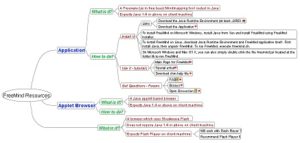Mind mapping is the art of creating an outline diagram with the idea or the topic of the map in the center with legs or roads coming off the center to break down a much larger idea, goal or concept. Although Tony Buzan is often credited with formalizing the concept of mind maps, at the end of the day people have used them for years. Their predecessor was the outline. However, ironically many outlines started as mind maps then were translated into mind maps at a later time for a better causational outcome.
What is the purpose of a mind map?
The purpose of a mind map will vary from application to application. However, the most normal purpose is to allow the person creating the mind map to mind dump their outcome and all of the pieces related to the desired outcome onto one piece of paper, or integrated screen. Ultimately the idea is to break the goal into subgoals which can then be broken into even smaller goals. Parents are the level up and the children are the smaller pieces that make of the parent. Some people also call these small pieces nodes. For the sake of our conversation, we will talk of them as parents and children. As each of the parent goals are achieved, many people will actually fill in or color the completed task. Once the children are completely full the parent is shaded. This allows the user to metric the success of the goal and measures the desired outcome.
Reaching for the goal:

 As the mind map is created it is designed from the point of reverse engineering the outcome. Commonly referred to as deconstructing the goal the process allows the user or mind mapper to “start with the end in mind”. Visually creating a graph where the end goal is the center of the attention, one can actually as I mentioned create an outline or checklist from the mind map. This, in turn, makes the larger and harder goal into several small digestible pieces. Many if not most people find it much easier to tackle small tasks and to disregard the larger tasks. The mind map user can, therefore, ignore the map beyond the section they are using. Then as the small goals are reached the user can move to the next bigger goal.
As the mind map is created it is designed from the point of reverse engineering the outcome. Commonly referred to as deconstructing the goal the process allows the user or mind mapper to “start with the end in mind”. Visually creating a graph where the end goal is the center of the attention, one can actually as I mentioned create an outline or checklist from the mind map. This, in turn, makes the larger and harder goal into several small digestible pieces. Many if not most people find it much easier to tackle small tasks and to disregard the larger tasks. The mind map user can, therefore, ignore the map beyond the section they are using. Then as the small goals are reached the user can move to the next bigger goal.
How to make a mind map:
I find the easiest way to create a mind map is a whiteboard. Depending on how big the outcome is I often start fairly small for the center goal, parents, and children. However, if you have room feels free to use it. As I draw my map I often draw small pictures and create words on the fly. The key is not to filter but just lend the brain dump everything onto the paper. It’s often more than beneficial to create notes and keys as you develop the map. Careful not to deep into any one topic, but at the same time be sure not to leave any ideas on the table. I also tend to keep a journal nearby as I’m mind mapping because as I am in the mode to create, I will usually come up with at least a hand full of ideas that have no place on my map.
In modern times people seek automation. Although at this time I don’t subscribe to endorse any single app for mind mapping, I have found a great open source (free) product that I have created a few maps with. Now, please be mindful that when I’m running a brain dump, that nothing will ever replace the freedom a whiteboard affords me, at the same time I realize that some people have terrible handwriting and they have no choice but to use a product like Free Mind – Source Forge. After all, it’s not rocket science and the process has been around for thousands of years. Free Mind is free and it allows you to create quick and easy completed mind maps without the hassle of needing someone to translate what you have written when you are done.
Why use a mind map?
 If you don’t have a system or the system you are using doesn’t allow you to take the stress of the desired outcome and everything the “big picture” has to offer, using a mind map can be a great tool to aggregate this information for you. They have been used in many forms throughout recorded history. However, the modern incarnation of the mind map allows the user to add pictures, draw lines and arrows that are not necessarily as neat and structured as is required by other charting and measuring paradigms.
If you don’t have a system or the system you are using doesn’t allow you to take the stress of the desired outcome and everything the “big picture” has to offer, using a mind map can be a great tool to aggregate this information for you. They have been used in many forms throughout recorded history. However, the modern incarnation of the mind map allows the user to add pictures, draw lines and arrows that are not necessarily as neat and structured as is required by other charting and measuring paradigms.
The modern mind map can allow the user to explore as quickly or slowly as they care to. Although many of the published maps are very crowded, I personally like mine to have space for notes and scribbles of my ideas. Pat Flynn has a great process for creating mind maps where he uses sticky post notes. He clearly shows that as you develop your ideas you don’t need to think one dimensional. Just be sure not to edit or censor any of your ideas, as if you do, you may not be able to make the jump to the next mental step you need to complete your desired outcome.
So as I discussed earlier, mind maps are a great tool to allow the user to put their ideas and concepts onto paper with a concise plan or diagram. It creates a great way to not only analyze the effectiveness of a goal but to measure the success and completion of the goal. Using pictures, notes and symbols you can create your own system to speed up the brainstorming process. Because of the lack of limitations concerning the design of the mind map, it is easy to be as creative as necessary to reach your goal. And I find most important in any brainstorming exercise is not to judge, filer or in any way censor the ideas that flow during the process. The purpose of the process is to mine for gold, why would you throw the gold out just because it may have a little dirt on it?
– J –